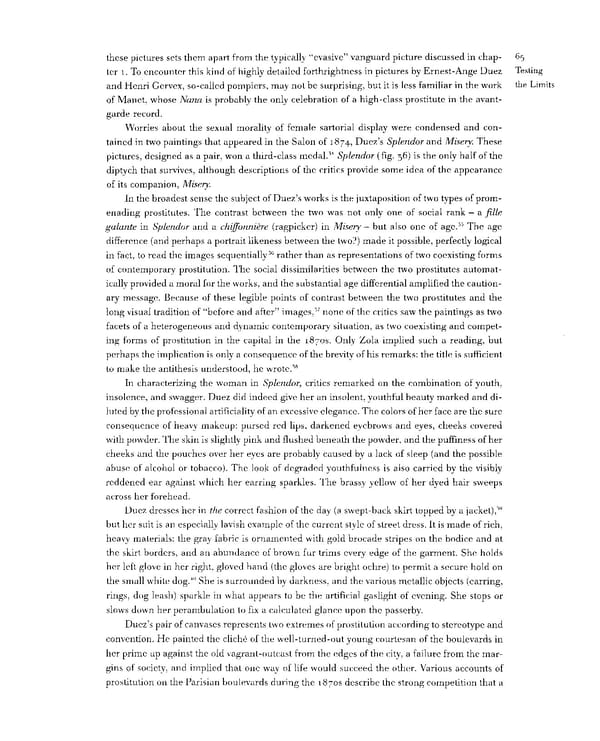these pictures sets them apart from the typically "evasive" vanguard picture discussed in chap- 65 ter i. To encounter this kind of highly detailed forthrightness in pictures by Ernest-Ange Duez Testing and Henri Gervex, so-called pompiers, may not be surprising, but it is less familiar in the work the Limits of Manet, whose Nana is probably the only celebration of a high-class prostitute in the avant- garde record. Worries about the sexual morality of female sartorial display were condensed and con- tained in two paintings that appeared in the Salon of 1874, Duez's Splendor and Misery. These 34 pictures, designed as a pair, won a third-class medal. Splendor (fig. 36) is the only half of the diptych that survives, although descriptions of the critics provide some idea of the appearance of its companion, Misery. In the broadest sense the subject of Duez's works is the juxtaposition of two types of prom- enading prostitutes. The contrast between the two was not only one of social rank — a fille 35 galante in Splendor and a chiffonniere (ragpicker) in Misery — but also one of age. The age difference (and perhaps a portrait likeness between the two?) made it possible, perfectly logical 36 in fact, to read the images sequentially rather than as representations of two coexisting forms of contemporary prostitution. The social dissimilarities between the two prostitutes automat- ically provided a moral for the works, and the substantial age differential amplified the caution- ary message. Because of these legible points of contrast between the two prostitutes and the 37 long visual tradition of "before and after" images, none of the critics saw the paintings as two facets of a heterogeneous and dynamic contemporary situation, as two coexisting and compet- ing forms of prostitution in the capital in the 18708. Only Zola implied such a reading, but perhaps the implication is only a consequence of the brevity of his remarks: the title is sufficient 38 to make the antithesis understood, he wrote. In characterizing the woman in Splendor, critics remarked on the combination of youth, insolence, and swagger. Duez did indeed give her an insolent, youthful beauty marked and di- luted by the professional artificiality of an excessive elegance. The colors of her face are the sure consequence of heavy makeup: pursed red lips, darkened eyebrows and eyes, cheeks covered with powder. The skin is slightly pink and flushed beneath the powder, and the puffiness of her cheeks and the pouches over her eyes are probably caused by a lack of sleep (and the possible abuse of alcohol or tobacco). The look of degraded youthfulness is also carried by the visibly reddened ear against which her earring sparkles. The brassy yellow of her dyed hair sweeps across her forehead. 39 Duez dresses her in the correct fashion of the day (a swept-back skirt topped by a jacket), but her suit is an especially lavish example of the current style of street dress. It is made of rich, heavy materials: the gray fabric is ornamented with gold brocade stripes on the bodice and at the skirt borders, and an abundance of brown fur trims every edge of the garment. She holds her left glove in her right, gloved hand (the gloves are bright ochre) to permit a secure hold on 40 the small white dog. She is surrounded by darkness, and the various metallic objects (earring, rings, dog leash) sparkle in what appears to be the artificial gaslight of evening. She stops or slows down her perambulation to fix a calculated glance upon the passerby. Duez's pair of canvases represents two extremes of prostitution according to stereotype and convention. He painted the cliche of the well-turned-out young courtesan of the boulevards in her prime up against the old vagrant-outcast from the edges of the city, a failure from the mar- gins of society, and implied that one way of life would succeed the other. Various accounts of prostitution on the Parisian boulevards during the 18708 describe the strong competition that a
 Prostitution & Impressionists Page 85 Page 87
Prostitution & Impressionists Page 85 Page 87